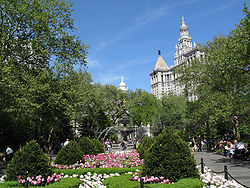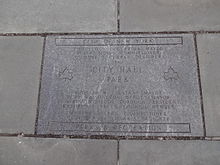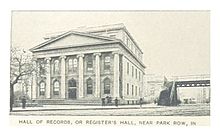
New York City Hall is the seat of New York City government, located at the center of City Hall Park in the Civic Center area of Lower Manhattan, between Broadway, Park Row, and Chambers Street. Constructed from 1803 to 1812, the building is the oldest city hall in the United States that still houses its original governmental functions. The building houses the office of the Mayor of New York City and the chambers of the New York City Council. While the Mayor's Office is in the building, the staff of thirteen municipal agencies under mayoral control are located in the nearby Manhattan Municipal Building, one of the largest government buildings in the world, with many others housed in various buildings in the immediate vicinity.

Collect Pond, or Fresh Water Pond, was a body of fresh water in what is now Chinatown in Lower Manhattan, New York City. For the first two centuries of European settlement in Manhattan, it was the main New York City water supply system for the growing city. The location of the former pond later became the site of a jail, and is now memorialized by Collect Pond Park, which includes a reflecting pool to acknowledge the historic importance of this body of water.

James Renwick Jr. was an American architect in the 19th century, noted especially for designing churches and museums. The Encyclopedia of American Architecture calls him "one of the most successful American architects of his time".
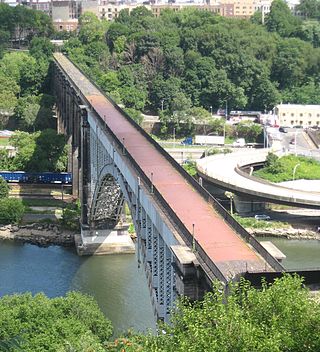
The High Bridge is the oldest bridge in New York City, having originally opened as part of the Croton Aqueduct in 1848 and reopened as a pedestrian walkway in 2015 after being closed for over 45 years. A steel arch bridge with a height of 140 ft (43 m) over the Harlem River, it connects the New York City boroughs of the Bronx and Manhattan. The eastern end is located in the Highbridge section of the Bronx near the western end of West 170th Street, and the western end is located in Highbridge Park in Manhattan, roughly parallel to the end of West 174th Street.
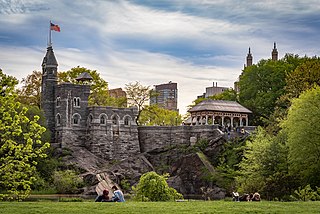
Belvedere Castle is a folly in Central Park in Manhattan, New York City. It contains exhibit rooms, an observation deck, and since 1919 has housed Central Park’s official weather station.
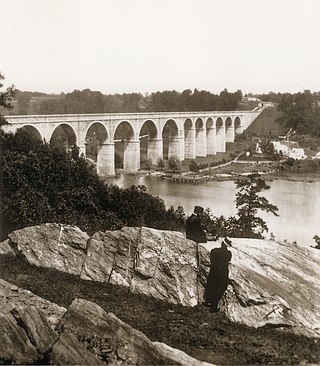
The Croton Aqueduct or Old Croton Aqueduct was a large and complex water distribution system constructed for New York City between 1837 and 1842. The great aqueducts, which were among the first in the United States, carried water by gravity 41 miles (66 km) from the Croton River in Westchester County to reservoirs in Manhattan. It was built because local water resources had become polluted and inadequate for the growing population of the city. Although the aqueduct was largely superseded by the New Croton Aqueduct, which was built in 1890, the Old Croton Aqueduct remained in service until 1955.

St. Paul's Chapel is a chapel building of Trinity Church, an episcopal parish, located at 209 Broadway, between Fulton Street and Vesey Street, in Lower Manhattan, New York City. Built in 1766, it is the oldest surviving church building in Manhattan, and one of the nation's finest examples of Late Georgian church architecture.

The New Croton Reservoir is a reservoir in Westchester County, New York, part of the New York City water supply system lying approximately 22 miles (35 km) north of New York City. It is the collecting point for water from all reservoirs in the Croton Watershed.

The Tweed Courthouse is a historic courthouse building at 52 Chambers Street in the Civic Center of Manhattan in New York City. It was built in the Italianate style with Romanesque Revival interiors. William M. "Boss" Tweed – the corrupt leader of Tammany Hall, a political machine that controlled the New York state and city governments when the courthouse was built – oversaw the building's erection. The Tweed Courthouse served as a judicial building for New York County, a county of New York state coextensive with the New York City borough of Manhattan. It is the second-oldest city government building in the borough, after City Hall.

St. Nicholas Park is a public park in Manhattan, New York City, between the neighborhoods of Harlem, Hamilton Heights and Manhattanville. The nearly 23-acre (93,000 m2) park is contained by 141st Street to the north, 128th Street to the south, St. Nicholas Terrace to the west, and St. Nicholas Avenue to the east.

The Jacqueline Kennedy Onassis Reservoir, also known as Central Park Reservoir, is a decommissioned reservoir in Central Park in the borough of Manhattan, New York City, stretching from 86th to 96th Streets. It covers 106 acres (43 ha) and holds over 1 billion US gal (3.8 million m3) of water.

The Croton Aqueduct Gate House is located in Manhattanville, Manhattan, New York City, New York. The building was built in 1884 and was added to the National Register of Historic Places on September 22, 1983. After being decommissioned in 1984, the below-grade valve chambers were filled and the building sat empty for nearly two decades. Between 2004 and 2006, architects oversaw an adaptive reuse project converting the gate house into theater space for Harlem Stage/Aaron Davis Hall.
Joseph-François Mangin was born on June 10, 1758, in Dompaire, in the Vosges region of France. He was a French-American architect who is noted for designing New York City Hall and St. Patrick's Old Cathedral in New York City.

The first decorative fountain in the United States was dedicated in Philadelphia in 1809. Early American fountains were used to distribute clean drinking water, had little ornamentation, and copied European styles.

McKenna Square is a 0.24-acre public green space in the Washington Heights neighborhood of Upper Manhattan in New York City. The park is located in a median of West 165th Street, between Audubon and Amsterdam Avenues. The triangular site was created in 1917 in conjunction of the widening of West 165th Street and was transferred to Parks in 1937.

The Rotunda was a building that stood in City Hall Park in Lower Manhattan, New York City, from 1818 to 1870.

The Croton Water Filtration Plant, is a drinking water treatment facility in New York City which began operation in 2015. The plant construction cost was over $3 billion, The facility was built 160 feet (49 m) under Van Cortlandt Park's Mosholu Golf Course in the Bronx.
